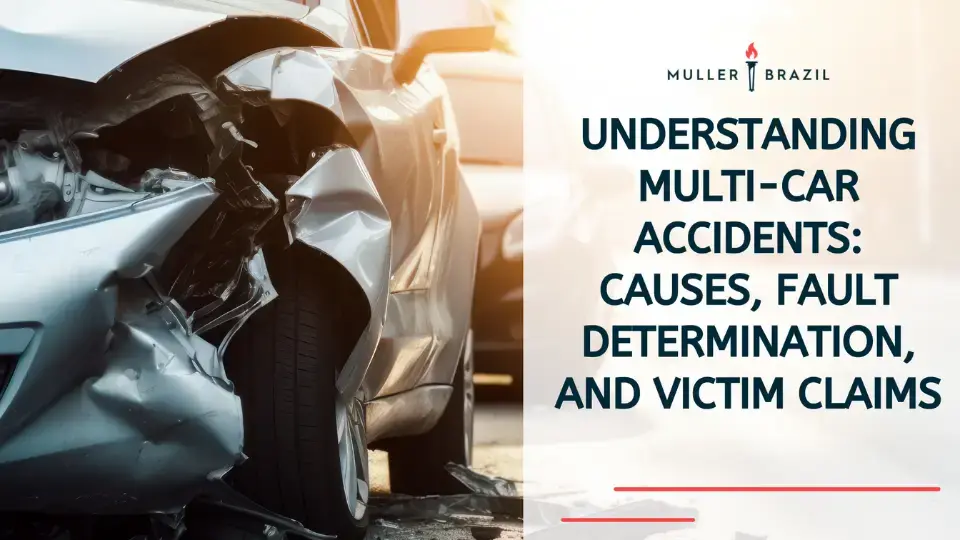4 min read
Understanding Multi-Car Accidents: Causes, Fault, and Claims
![]() Paul R. Brazil, Esquire
Jun 26, 2024 10:07:05 AM
Paul R. Brazil, Esquire
Jun 26, 2024 10:07:05 AM
Multi-car accidents, also known as pileups, chain reaction crashes, or multiple vehicle collisions, are unfortunately all too common on our roads. According to the National Highway Traffic Safety Administration (NHTSA), about 40% of all car accidents in the United States involve multiple vehicles.
These accidents are chaotic and stressful, often involving numerous vehicles and complicated scenarios. In Pennsylvania alone, the Department of Transportation reported over 104,000 traffic crashes in 2020, with a significant portion involving multiple vehicles. The most frequent causes include distracted driving, speeding, and adverse weather conditions. Understanding how fault is determined in these situations is key, especially in states like Pennsylvania where specific laws and rules apply.
Clarifying the process of determining fault and the concept of comparative negligence in Pennsylvania helps victims understand their rights and the steps to take if they find themselves in said situation. Whether you're involved in a multi-car pileup or simply want to be prepared, we will provide you with insights and advice below.
Determining Fault
In the aftermath of a multi-car accident, one of the most important tasks is determining who is at fault. Fault determination is key because it influences insurance claims and liability for damages. In Pennsylvania, the process involves a combination of police reports, witness statements, and physical evidence.
Role of Police Reports and Evidence
When a multi-car accident occurs, the police typically arrive at the scene to manage the situation and compile a report. This report includes specific information such as:
- Statements from drivers and witnesses: These accounts help piece together the sequence of events leading to the accident.
- Photographs of the scene: Photos provide visual evidence of vehicle positions, road conditions, and damages.
- Physical evidence: This includes skid marks, vehicle damage, and debris, which offers insights into the collision dynamics.
The police report is pivotal for insurance companies and legal teams to assess fault. However, you should note that the police officer's assessment of fault is not always definitive and can be contested.
Pennsylvania's Comparative Negligence Rule
Pennsylvania follows a comparative negligence rule, which means that more than one party can be found at fault for an accident. Under this rule, the fault is assigned as a percentage to each party involved. For example, one driver may be found 70% at fault while another is 30% at fault.
In Pennsylvania, a key aspect of comparative negligence is the "50% rule." This rule states that if a driver is found to be 51% or more at fault for the accident, they cannot recover any damages from the other parties involved.
However, if a driver is 50% or less at fault, they can recover damages, but the amount will be reduced by their percentage of fault. For instance, if you are found to be 30% at fault and your damages total $10,000, you can recover $7,000 (i.e., $10,000 minus 30%).
Victim Claims
After a multi-car accident on one of Philadelphia’s most dangerous roads, victims often face physical, emotional, and financial challenges. Understanding what you can claim as a victim is key to recovering losses and getting back on your feet. In Pennsylvania, victims of multi-vehicle collisions can file claims for various types of damages.
Types of Claims Victims Can Make
Medical Expenses
- Immediate Medical Costs: These include emergency room visits, surgeries, and any other immediate medical attention required after the accident.
- Ongoing Medical Treatment: This covers physical therapy, follow-up visits, medications, and any long-term care needed due to injuries from the accident.
Lost Wages
- Current Lost Wages: Compensation for the income lost during the recovery period.
- Future Lost Earnings: If injuries lead to long-term or permanent disability, victims can claim compensation for future lost earning potential.
Pain and Suffering
- Physical Pain: Compensation for the physical pain endured due to the accident.
- Emotional Distress: Compensation for psychological impacts such as anxiety, depression, or PTSD resulting from the accident.
Property Damage
- Vehicle Repairs or Replacement: Costs for repairing or replacing a damaged vehicle.
- Personal Property: Compensation for other personal items damaged in the accident, such as electronics, clothing, or luggage.
Loss of Consortium
- Compensation for the impact on a victim’s relationship with their spouse, including loss of companionship, affection, and sexual relations.
Contact Us Now
Process of Filing a Claim
Document Everything
- Medical Records: Keep detailed records of all medical treatments and expenses.
- Work Records: Document any time off work and how it has affected your income.
- Photos and Evidence: Take photographs of injuries, vehicle damage, and the accident scene if possible.
Report the Accident
- Notify Insurance Companies: Inform your insurance company and the at-fault driver’s insurance company about the accident.
- File a Police Report: Make sure the accident is officially recorded with a police report, which will be critical for your claim.
Consult with a Personal Injury Lawyer
- Legal Advice: A lawyer will help you understand your rights and the best course of action.
- Claim Preparation: They will assist in gathering evidence, negotiating with insurance companies, and representing you in court if necessary.
How long does a car accident settlement take? Read more.
Scenarios and Examples
Understanding fault in multi-car accidents can be complicated. Here are simplified scenarios to show common situations:
Chain Reaction Rear-End Collision
- Example: Car A stops suddenly. Car B hits Car A. Car C, following too closely, hits Car B.
- Fault: Car B is primarily at fault for hitting Car A. Car C shares fault for following too closely.
- Outcome: In Pennsylvania, comparative negligence applies. If Car B is 70% at fault and Car C is 30%, compensation is adjusted accordingly.
Intersection Collision
- Example: Car A runs a red light and hits Car B. Car C is hit by Car B.
- Fault: Car A is at fault for running the red light. Car B is not at fault if it was proceeding legally. Car C's involvement is secondary.
- Outcome: Car A is primarily responsible for damages to Cars B and C.
Highway Pileup
- Example: Car A stops suddenly due to debris. Car B swerves and hits Car C. Car D hits Car A.
- Fault: Car A might not be at fault if the stop was necessary. Car B shares fault for losing control. Car D is at fault for not maintaining a safe distance.
- Outcome: Fault is distributed among Cars B and D based on their contributions to the accident.
Speak to us Now
Conclusion
Dealing with a multi-car accident can be overwhelming, especially when determining fault and understanding Pennsylvania's comparative negligence laws. To guarantee that you are adequately protected and receive fair compensation, it’s important to be informed and prepared.
If you find yourself involved in a multi-car accident, remember to:
- Understand Fault: Know how fault is determined and the role of comparative negligence.
- Document Everything: Gather evidence, take photos, and collect witness statements.
- Know Your Insurance Options: Understand the differences between no-fault and traditional liability insurance.
- Seek Legal Advice: Consult with a car accident lawyer to protect your rights and secure fair compensation.
For expert legal assistance and support with your case, turn to the team at Muller Brazil. We specialize in personal injury law and can provide you with the guidance and support you need during this challenging time.
Meet the Author
Paul Brazil - Founding Partner
Paul Brazil is a native of Dunmore, Pennsylvania and a graduate of Dunmore High School. For his undergraduate education, he attended Bloomsburg University where he majored in political science. He then went on to earn his JD from Widener University School of Law. Following graduation from law school, Mr. Brazil worked at a large Philadelphia civil defense firm where he litigated workers’ compensation claims and Heart and Lung Act cases.
Learn more about Paul Brazil ⇒


